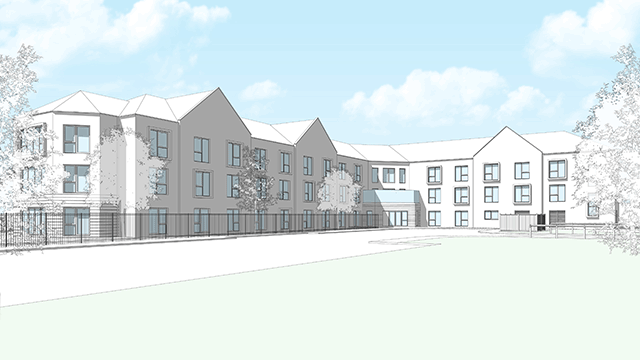Armed with £200m of funding, the UK government has started its search for a city where it will run large-scale tests for 5G – the next generation in ultra-fast wireless technology.
Along with universities and partners in both the public and private sectors, the government will test how to set up the infrastructure needed to make cities across the country more efficient – not least because Brexit has stepped up the urgency for increased productivity.
The resulting possibilities are staggering: driverless cars will be able to talk to each other with next to no lag, making them safer; retailers could use virtual or augmented reality to improve user experience; and at the very least you might even be able to connect to your e-mail while on a train.
Although the possibilities are still hypothetical – few concrete standards have yet to be agreed for 5G – and the government’s tests are expected to run well into the 2020s, property needs to think about how 5G will change what is required from buildings and how economic activity will change geographically.
Rick Robinson, digital property and cities leader at Arup and board member for national innovation network UK5G, says: “We already work with property developers to tackle problems they have when their quantity surveyors don’t put sufficient budget in their plans to pay for communications infrastructure.”
For example, residential developments need the bandwidth to support growing demands for faster internet or higher-definition TVs if they want to attract tenants.
But 5G will take things a step further. The technology is based on superfast speeds, and achieving that means using high frequencies that do not travel far or through thick walls.
“Because it’s high frequency, it will require more repeaters, more base stations throughout the buildings. The space, power and backbone of fixed connectivity to support them will all need to be included in building plans,” Robinson says.
The government estimates an area the size of the City of London will need 42,000 “small cell” radios to deliver consistent 5G connectivity. By comparison, there are about 40,000 radio access points throughout the entire UK now.
One of the government’s major focuses is rural coverage – to open up areas that have been cut off from the UK’s economic centres.
Cisco and the University of Strathclyde won a £4.3m government grant to run 5G trials on the Orkney Islands and other rural areas to find ways local industries could benefit from better connectivity.
Robinson says: “If left to the market, the network providers will first invest in infrastructure where the economy is already the healthiest because that’s where they will get the quickest returns.
“There is a risk that if nothing else is done we might create a worse problem than we already have in terms of the digital accessibility gap.”
The question the industry needs to consider is if rural areas do get better connected to the rest of the country, does that open up opportunities for development across all asset types?
Getting ready for the revolution
There are more questions than answers for property where 5G is concerned.
Mark Hurst, Ellandi’s asset management director, says: “5G is of great interest not only for the increased speed but potentially also the ability for future smart buildings and internet of things connectivity, the exact method and application of which the industry is still grappling with.”
Although companies should start investing in people who can help them figure out the benefits of 5G, thinking ahead also has its dangers.
“Using these types of technologies is a new thing for the property industry,” says Robinson. “There isn’t a huge library of case studies that says: ‘If you’re this type of company with this type of portfolio, this type of building, this is the precise calculation for the business case for using this technology.’”
As with any innovation, early adopters have the opportunity to get the most value out of it – if they get it right. But, Robinson adds: “Many organisations prefer to take a second-adopter stance because often the first adopters of technology don’t get it right and can spend an awful lot of money.”
But regardless of whether you are a first or second adopter, 5G will become a reality in the next few years. If you do not have the flexibility and the skills to respond to it, you will be left behind.
COMMENT: ‘Will there be a winner in the global race for 5G?’


From Bristol to New York, Seoul and Tallinn, there has been much speculation over which city is leading in 5G. An agile approach to its development is under way, meaning there is no one leader, with each country exploring different trends, say Sanjaya Ranasinghe, technical director, and John Meko, director of engineering USA, at WiredScore.
The global hotbed for 5G innovation makes this an exciting time for the industry in general and, slowly, more is becoming clear about what we can expect from 5G and how we can start preparing our buildings and cities to benefit from its roll-out.
Laying the foundations
Most development and investment so far has been in 5G fixed wireless access. FWA provision comes from small microwave antennas, similar in form to tablets, mounted on the roof of a buildings providing fibre-like internet connectivity for businesses.
FWA is not a new concept but the advent of 5G will enable it to become ubiquitous in comparison to its current use case, where it has been mainly reserved for back-up connections in commercial offices, and for buildings that are out of reach of fibre infrastructure.
While carriers don’t yet know what the exact standard of 5G FWA will look like, they know that fibre backhaul will be its foundation.
In the US, we’ve seen a strong drive for investments and acquisitions from providers such as AT&T and Verizon to secure fibre network assets to accommodate their future 5G deployments.
Make the distance
The focus of early 5G efforts by Verizon Wireless and other carriers in the US have been on the higher end of the Radio Frequency spectrum (28GHZ), that are relatively untapped and can support higher data rates due to the greater bandwidth available.
However, operating at higher frequencies has the knock-on effect of reducing the distance at which a reliable signal can be received and also makes transmission susceptible to being blocked by building materials.
This approach has been criticised by Bruno Jacobfeuerborn, Deutsche Telekom’s chief technology officer, who predicted that a large-scale roll-out of the infrastructure required to support these short distances could run to as much as $300bn in the US alone – a cost that would prevent any carrier from upgrading to 5G at a national level.
To tackle these distance issues, South Korean SK Telecom has been trialing the use of repeaters and has shifted from testing in the 28GHz band to the 6GHz band, which operates over longer distances.
The second and more widely anticipated wave of 5G trials are set to take place later this year with pilots of 5G “Mobile”, a future replacement for 4G Long Term Evolution networks.
Unlike 5G FWA, these tests will deliver ubiquitous high-speed, ultra-low latency cellular networks.
These networks will enable lower latency connections needed for cellular-connected autonomous vehicles and internet of things devices, while delivering speeds 100 times of what our cell phones currently reach.
South Korea’s top mobile carriers have also decided to collaborate on a common nationwide 5G infrastructure.
And the race is now on for smartphone providers to deliver this to the handset, with the Huawei Mate 30 the first 5G-enabled phone to be announced.
Readying our cities
While the full standard has yet to be announced and ratified, ambitions are high for 5G.
The EU has indicated it wants every member state to introduce it in at least one major city by 2020.
As such, every city in the world has the potential to be a 5G “winner”. But its success is not just down to telecoms providers.
Landlords must be prepared for 5G to change the role of buildings within the digital infrastructure network.
Owners can no longer be passive observers waiting for providers to install and relay their connections internally.
They must become an active participant in making their building 5G-ready and transforming it into a critical piece of the city’s larger network, joining with public assets as sites for small cell deployments to relay the 5G network.
This shift is being enabled in the UK by reforms to the Electronic Communications Code, so operators can take private landowners to court if they refuse to install or maintain network apparatus.
The government hopes this will encourage an open dialogue between operators and landlords, making it easier for operators to provide the network for 5G.
Building designers need to start thinking about how they will incorporate this into buildings, while building owners must be prepared to potentially invest capital so cellular signals proliferate to all users in the building.
Understanding the network changes that 5G will require, as well as its benefits, will ensure the industry is an enabler to its roll-out.
This will require a cohesive effort to usher in a new era of the way wireless technology is used to shape our lives. It is clear to see that building owners who are willing to take part in this evolution will play a key role in enabling their city to be a 5G winner.
COMMENT: ‘5G: Five ways it’s a game-changer’

There are a number of technologies poised to change the world, and they all rely on one thing – connectivity. However, as demand on our networks increases, current connectivity technologies such as 4G can’t deliver the speed or reliability required to process the growing volume of data, says Tom Redmayne, director of business development, UK and Ireland, WiredScore.
5G is the game-changer – increasing data rates, reducing data transfer delays (latency) and supporting an increased number of devices. In fact, the latency delivered by 5G is just 9ms – remarkable when you consider the human brain has a latency of 13ms.
But how will 5G impact the innovations you care about?
Bringing commercial speeds to the home
Many 5G use cases have focused on fixed wireless applications for residential and retail, as opposed to mobile applications.
The deployment is similar to that of existing fixed wireless infrastructure but offers the same reliability and high-speed connection as enterprise-grade fibre.
As the last mile is the most expensive when making fibre connections, this will provide a more cost-effective way for internet service providers and developers to deliver high speeds to residential developments.
Commercial landlords will also be able to leverage 5G fixed wireless as a way for tenants to get set up with the internet quickly while waiting on wayleave agreements for fibre installation, as there is no need to dig up the street or put holes in buildings.
Additionally, 5G fixed wireless can deliver a seamless enterprise-grade back-up service if there is disruption to the primary source of internet provision.
In Texas, AT&T has already showcased the potential speeds at the Magnolia Market at the Silos, bringing a fantastic experience to its customers while allowing the telecommunications giant to learn more about 5G.
Fuelling autonomous cars
The lower latency and increased data rate of 5G connections will deliver the capabilities driverless cars need.
Far beyond delivering increased resolution and details of maps, 5G will also enable communication between vehicles and other data sources in real time to provide insights outside of the range of the sensors currently positioned on the car.
So if a car were to swerve into your lane a mile ahead, the system could react to that external data.
This is in comparison to the human-like scope of sensors positioned within and around a vehicle today and will move self-driving cars to full autonomy.
Powering the internet of things
There has been extensive discussion around how the internet of things will revolutionise the way we interact with cities, buildings and services.
5G networks will deliver the reliability, latency and mobility needed for a seamless experience of connected devices and services no matter where you are.
In a commercial environment, using private 5G networks will support more secure connections between each device to prevent hacking.
As the number of connected devices across smart buildings and cities explodes, 5G will manage the flow of data created to the cloud, which on that scale would have previously flooded the network.
A new reality
5G will bring a new era for augmented reality and virtual reality, with the lower latency delivering a flawless experience.
This will shift greater processing to the cloud, so the size of headset will become smaller and more ergonomic, making AR and VR a more practical tool.
We are already seeing innovative applications across real estate, such as tenants using VR headsets to design the layout of new office spaces in real time, providing them more customisation than with pre-constructed buildings.
Some companies are even using it with BIM to create immersive digital maps of a building’s cables and piping.
A new definition of fast
For the general consumer, the greatest difference will be the speed at which 5G can process data.
It is able to handle 1,000 times more traffic than other networks and is 10 times faster than 4G cellular networks – that’s fast enough to download a HD film in just under seven seconds.
This will enable us to work where we want and how we want.
This will truly transform the working environment, with placemaking growing in importance. Creating well-connected spaces where people want to work and play will assure the future value of assets.
The office can no longer be considered as the sole place that connectivity is key within a development. 5G can provide this seamless connectivity requirement across a site be it via FWA or high-speed mobile.
Of course, while promising remarkable improvements, the speed at which 5G will be delivered will depend on the evolution of urban infrastructure to accommodate these innovations, with London alone estimated to require some 100,000 small cell sites.
Investment will be required globally from numerous industries and government if we are to reap its benefits.
To send feedback, e-mail karl.tomusk@egi.co.uk or tweet @ktomusk or @estatesgazette











